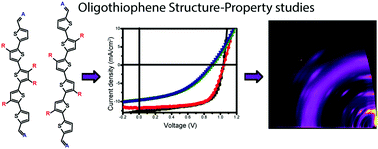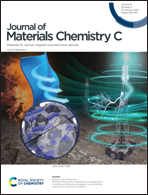A structural study of p-type A–D–A oligothiophenes: effects of regioregular alkyl sidechains on annealing processes and photovoltaic performances†
Abstract
In this study we report on a series of 12 small molecular p-type penta- and hexathiophene semiconductors end-capped with either malononitrile (MN), hexyl rhodanine (HR) or dicyano hexyl rhodanine (CHR) acceptors and functionalized with alkyl sidechains of two different lengths, orientated away from the central core in a regioregular manner. Organic photovoltaic devices were fabricated, and annealed using conditions optimized for each material to produce a wide range of power-conversion efficiencies (PCEs) from 1–8%. We find that achieving high PCEs is critically dependent on matching the conjugation length to specific end-group acceptors, and also find a slight correlation between improved performances and longer sidechains. To understand this behavior we performed an in-depth analysis of the structure–property relationships of these materials on intermolecular packing through grazing-incidence wide-angle X-ray scattering (GIWAXS) studies, which yielded several key relationships between molecular structure, bulk crystallinity and optoelectronic properties.



 Please wait while we load your content...
Please wait while we load your content...